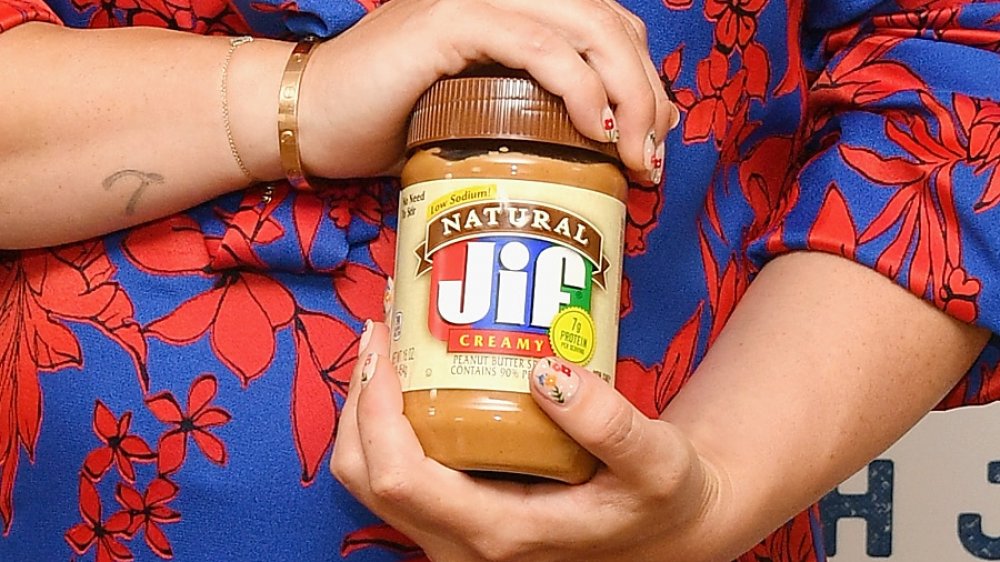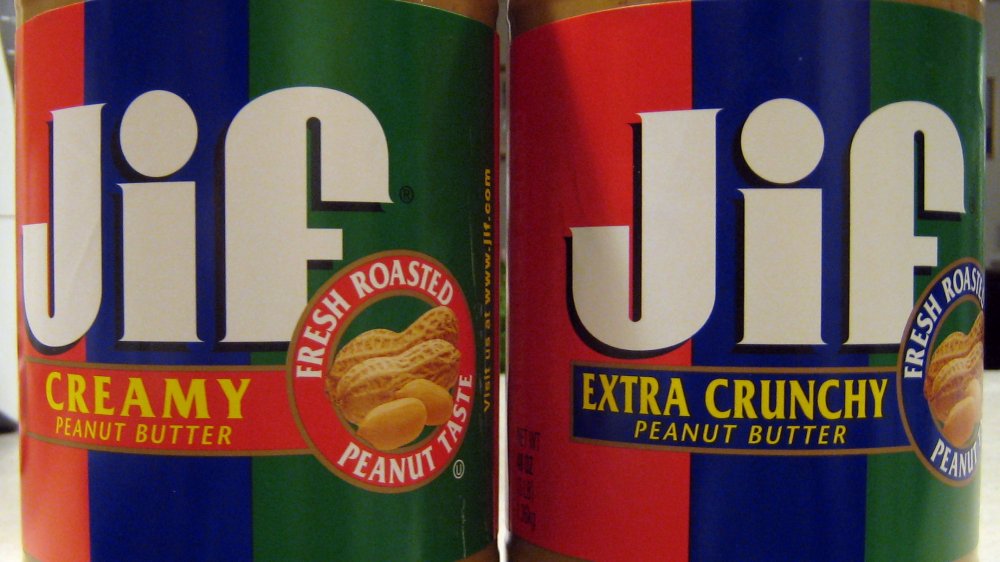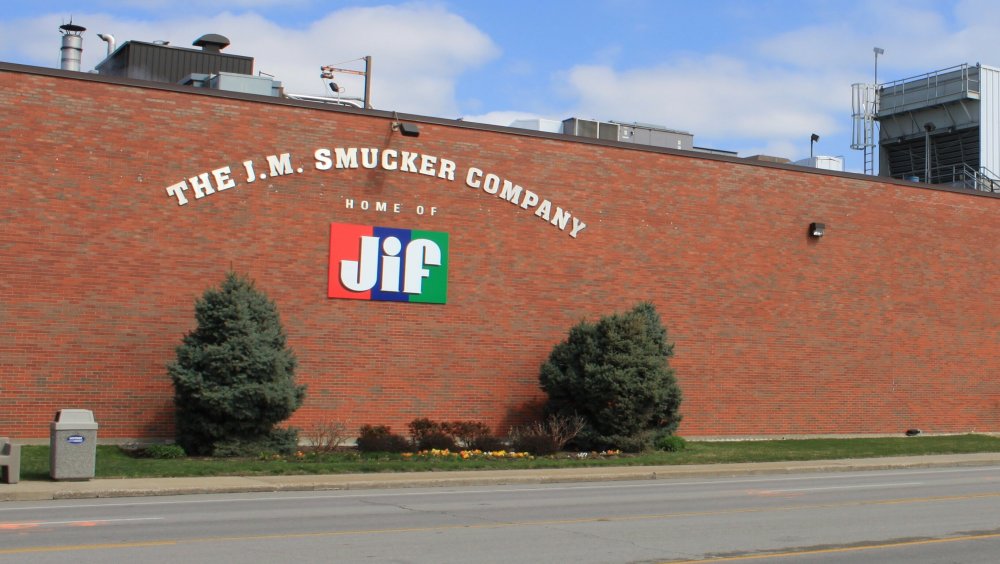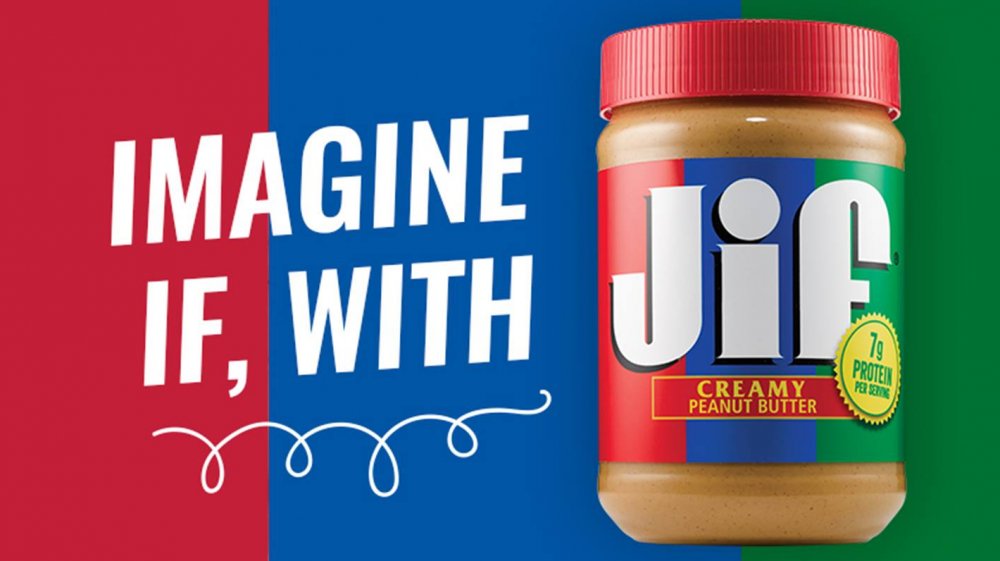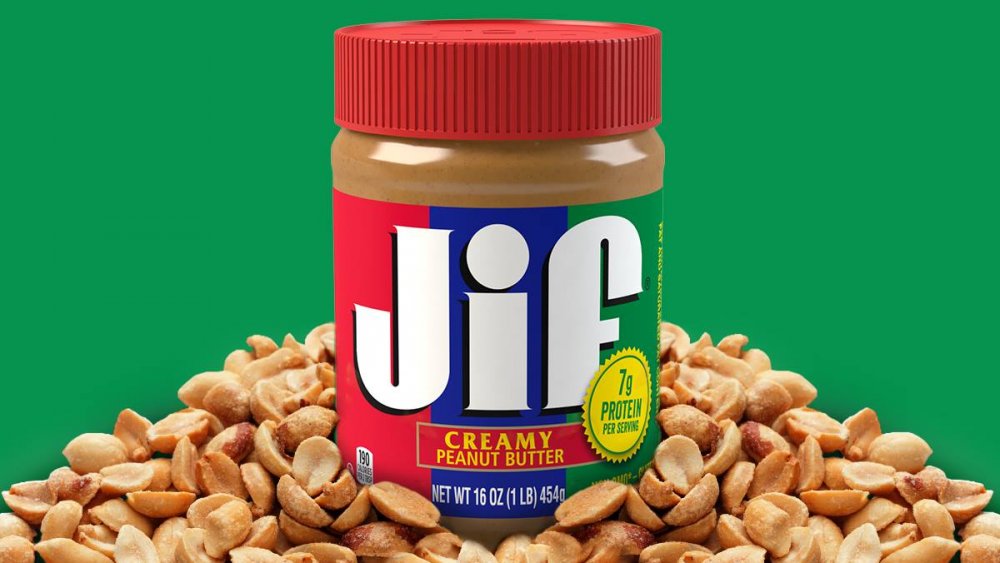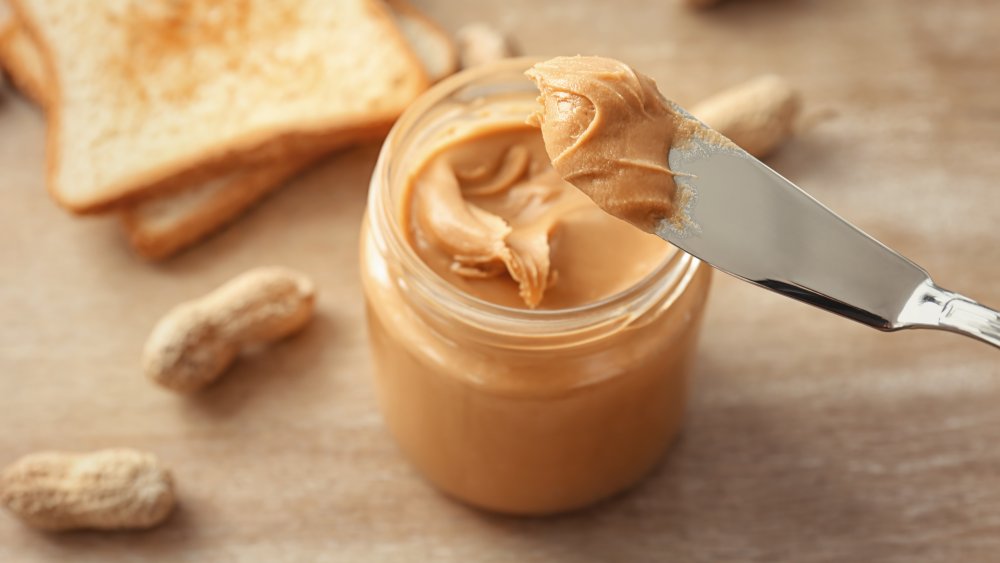The Untold Truth Of Jif Peanut Butter
Peanut butter has a long and interesting history. Evidence points to the Incas being the first people to grind peanuts, and the first person who made peanut butter in the United States was John Harvey Kellogg, who invented a form of it in 1895 (via National Peanut Board). Jif was born more than half a century later in 1958 (via Jif).
Of all of the peanut butter brands on the market, Jif, with its colorful and easily recognizable logo, is one of the most widely known manufacturers of the creamy, sticky lunch staple. A couple of years ago, that logo made the internet have something of a meltdown when people on social media pointed out the fact that it looks quite similar right-side-up as it does upside down. A representative for J.M. Smucker, the jam manufacturer that purchased the brand in 2002, indicated that this feature was unintentional (via Insider). Next time you decide to make yourself a peanut butter and jelly sandwich, give your Jif jar a flip and decide whether that reversible logo really could have been done without trying.
Jif versus the FDA
Jif arrived on the scene after Skippy and Peter Pan, its two main competitors, which still exist to this day (via Jif History). Jif's history actually begins with a small-time peanut butter maker being acquired by a much larger corporation. After Procter & Gamble purchased a peanut butter brand called Big Top from a Kentucky company, they revamped the brand by adding sugar and molasses, included oils other than peanut oil in the recipe, and branded the new concoction Jif (via The New Yorker).
The addition of these new ingredients resulted in some legal battles with the Food and Drug Administration. Because Skippy and Peter Pan decided to follow suit and add non-peanut products to their mixtures, while the FDA was pushing for the definition and the labeling of peanut butter to require the mixture to be made up of 95 percent peanuts, the peanut butter industry wanted the number to be 87 percent. After twelve years of back and forth, a compromise was reached at 90 percent.
Jif varieties and marketing campaigns
Of course, for all of the initial fighting with the FDA, the predominant ingredient in Jif is still peanuts and the brand certainly uses a lot of them. It's estimated that 188 billion peanuts are needed to manufacture Jif peanut butter. According to data obtained from the J.M. Smucker Company, one in every 10 peanuts grown in the United States winds up in a jar of Jif (via WKYT)
As with many well-known American brands, JIF has engaged in a number of successful marketing campaigns that have helped cement their status on grocery store shelves. A blue Kangaroo named Jifaroo was used as the mascot when the brand was introduced in 1958, but the marsupial disappeared from advertising in the 1960s (via Neato Coolville). Jif's ad campaign "Choosy mothers choose Jif" helped make Jif the best-selling peanut butter in the country, a position that it has held consistently since 1981 (via J.M. Smucker).
In 1974, the first variety of Jif was introduced to the market — Jif Extra Crunchy. It was followed by Simply Jif (a variety with low sodium and less sugar than regular Jif) in 1991, and Jif Reduced Fat in 1995. Today, Jif also offers peanut butter made with honey instead of sugar, peanut butter with no sugar at all, and even peanut butter with Omega 3 fatty acids in the form of fish oil.
Jif or Jiffy
A bit of a bizarre Jif-related phenomenon hit the internet a few years back. A large number of people online seemed to be remembering that Jif was once called Jiffy. This was, as it turns out, 100 percent incorrect, with a J.M. Smucker representative even telling Insider that "Jif was never named Jiffy." The incident was considered an example of the Mandela Effect, a pop culture phenomenon that involves the misremembering of something by large segments of society. It was named after Nelson Mandela, who many people mistakenly thought died in prison in South Africa in the 1980s, though he really lived until 2013. There are a number of reasons people might be misremembering the name of their favorite peanut butter.
They might be blending the name Jif and Skippy together to come up with a new brand that never existed, or they may be getting their childhood foods mixed up and are introducing Jiffy Pop into the mix. They also may be remembering a Jif marketing campaign that suggested that people could use peanut butter to whip up lunch "in a jif-fy." Whatever the reason, there were quite a few people who bought into this line of thinking. Redditors wrote that they distinctly remember holding jars of Jiffy in their hands and one even went so far to describe what they thought the jar was like: taller and skinnier than the Jif jar (via Reddit).
Jif expands and makes social commitments
The company isn't resting on its laurels as the most popular peanut butter producer in the country, though. In 2012, Jif moved into hazelnut spreads in chocolate and mocha cappuccino flavors (via Food Processing). They also offer cashew butter and almond butter. They've also taken steps to ensure that the palm oil used in their spreads is sourced sustainably, as deforestation in Southeast Asia as a result of palm oil plantations is a growing concern.
The Jif site says in 2015, the company began purchasing all of its palm oil from a traceable and sustainable source. This means that they work to protect forests and peatlands – the likes of which are often razed by palm oil farmers (via ProPublica) – and work to foster reputable labor practices as well given that child labor and human trafficking occurs all too often in the industry as well.
Jif peanut butter by the numbers
It's clear that America has a thing for peanut butter, and especially Jif. According to WKYT, who provided a number of fun facts about this iconic product in 2018, we consume 270 million pounds of Jif each year. That equates to almost 113 million people eating Jif in 2019, according to Eat This, Not That!, who reports that Jif is the most popular peanut butter on store shelves.
As for what's inside the jar? There are approximately 1,200 peanuts making up a 28-ounce container of Jif. If you're thinking that means J.M. Smucker Company must use a lot of peanuts, you're not wrong: One in 10 peanuts end up in this particular brand of PB.
